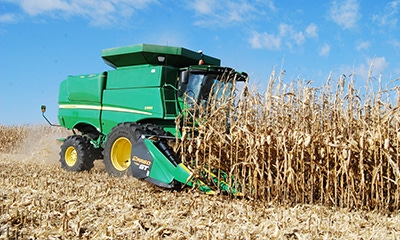September 30, 2016

Ag lenders have reported large net equity losses for some row crop farms the past couple years. You can expect this trend to continue as lenders update farmers’ balance sheets in the future, a few months from now. Many farms will have excess bushels of unpriced grain and may face running out of cash or time for cash prices to rise in order to pay down existing obligations.
Record 2016 Iowa and U.S. corn and soybean production and yields are forecast. Those extra bushels should benefit a farm’s total crop revenue. However, a farmer who didn’t do a good job of managing futures price risk this past spring could run into cash flow problems ahead.

RECORD PRODUCTION HELPS: Good yields this fall will help boost a farm’s total crop revenue. However, a farmer who didn’t do a good job of managing futures price risk this past spring could run into cash flow concerns in the months and year ahead.
Preharvest marketing. Farmers who did a good job of forward contracting new crop bushels, hedging or buying put options this spring will avoid many cash flow concerns. However, those farms holding large quantities of unpriced crops could see cash flow challenges and may want to focus on their marketing strategies now. Perhaps they should make some local cash sales at harvest or deliver to a processor where better cash prices reflecting basis exists.
Work with your lender. If you know cash flow is already going to be a problem, communicate early with your lender ahead of time. Many lenders spent the past couple of winters restructuring existing farm debt to stretch out principal payments and free up depleted working capital. These same lenders could be reluctant to restructure loans any time soon without commitment of the farmer to improve their cash flow management.
These cash flow problems will likely appear in October with interest or penalties incurred for late property tax payments and crop insurance premiums. Farms without access to typical farm operating loans should avoid advancing family living and farm expenses on credit cards or higher interest-bearing debt.
USDA’s Farm Service Agency (FSA) does offer a low-interest, nine-month non-recourse marketing loan on harvested grain; but FSA requires that the on-farm stored bushels be measured or the commercially stored grain is under warehouse receipt. This marketing loan is limited at the county loan rates, which are below the national loan rates of $1.95 per bushel for corn and $5.00 per bushel for soybeans.
Avoid long-term commercial storage. Waiting until after harvest for corn and soybean futures prices to rebound along with basis improvement may take several months. You can expect on-farm storage space will be tight this fall as harvest wraps up and basis remains abnormally wide. However, storing on-farm likely means lower costs for drying, shrink and overall storage costs. Perhaps the greatest benefit of storing on-farm besides harvest efficiency is that it allows the farmer more time and improved chances to shop around for better cash prices reflected in basis.
Commercial storage space should be available at harvest, but basis will be limited as huge piles of corn on the ground appear at many elevators and cooperatives. Limitations of commercial storage costs and accruing interest on existing debt along with any short-term basis improvement negates many benefits for a positive net return to grain ownership until perhaps spring of 2017.
With more farms facing cash flow constraints this fall, they should consider the delivery of bushels at harvest. By communicating with the grain merchandiser in advance, you can still “stay long in the deferred futures” using a basis contract and/or a minimum price contract. Much of the actual cash price of the grain will be received upon delivery. Thus, you generate needed cash flow and eliminate storage costs, basis risk and accrued interest. You still have futures price risk in those deferred contract months, so you’ll need to work with your grain merchandiser to “short futures” before that futures contract goes into delivery.
Conclusion. Cash flow is an underlying concern for many Iowa farms this fall. Unless a farm is self-financed, has access to credit or did a good job of preharvest marketing new crop bushels, you can expect cash flow challenges to emerge this fall and early winter.
The ISU Extension Ag Decision Maker website has a variety of resources for farm financial planning and stress management. Assistance can be provided in assessing a farm's financial situation including one-on-one financial analysis and advice to help farmers with grain drying and shrink strategies. One-on-one financial counseling, a computerized analysis of the farm business, and referral to other Extension programs or outside services are also available.
* For more information, visit Changing Farm Financial Conditions at
extension.iastate.edu/agdm/info/currentissues.html. This website has resources for financial planning and stress management from Iowa State University Extension and Outreach. These resources are available to assist in assessing a farm's financial situation.
Johnson is the Iowa State University Extension farm management specialist for central Iowa. Contact him at sdjohns.iastate.edu.
You May Also Like




